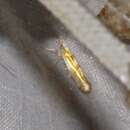Conservation Status
provided by University of Alberta Museums
Not of concern.
- license
- cc-by-nc
- copyright
- University of Alberta Museums
Cyclicity
provided by University of Alberta Museums
Adults appear early in May and remain on wing until August (Prentice 1965: : 792; Dyar, 1904: 933).
- license
- cc-by-nc
- copyright
- University of Alberta Museums
Distribution
provided by University of Alberta Museums
In United States, it is recorded from Michigan (Nielsen 1998: 7) and Seattle, Washington (Busck, 1907: 13). In Canada, there are widely scattered collection records from British Columbia, Alberta, Saskatchewan, Manitoba and Ontario (Forbes 1923: 346; Prentice 1965: 791). In Alberta, it has been collected from Edmonton, Red Deer, Kananaskis Forest Environment Station, northwest Whitecourt, Carvel, Robb, Watt Mountain, Hinton, Hillcrest and Lac La Biche.
- license
- cc-by-nc
- copyright
- University of Alberta Museums
General Description
provided by University of Alberta Museums
"Wingspan 11-14 mm. Head golden white, frons shining brassy white; antenna distinctly annulated with dark brown and whitish, scape pale ochreous; labial palpus golden white. Thorax golden-white, tegulae golden. Forewings with Veins R4 and R5 separate; apical markings coarse; Forewings white suffused with pale golden; a square golden spot on dorsum connected to base by a broad streak astride fold, sometimes extended with irroration beyond spot in middle of wing; a broader gold mark on dorsum at halfway extended obliquely across half to three-quarters of wing; a gold spot at tornus, sometimes extended by irroration into apical area; cilia generally concolorous with adjacent part of wing. Hind wing grey, darker towards apex. Legs brassy white; forewing brown above. Abdomen grey (Emmet et al 1996: 80-81; Busck, 1907: 13; Forbes 1923: 386). Busck (1907: 13) points out that "Specimens from B.C. and Seattle do not differ from European Series", and Forbes (1923: 346) indicates "If the American form is distinct, its name will be chalcochrysa Meyrick".
In Alberta, A. pygmaeella can be easily distinguished from other Argyresthia by its forewing color and pattern. Closely similar to this species is A. conjugella which does not have the golden color on forewings.
"
- license
- cc-by-nc
- copyright
- University of Alberta Museums
Habitat
provided by University of Alberta Museums
Chiefly montane, but also boreal and prairie habitats where Salix is common.
- license
- cc-by-nc
- copyright
- University of Alberta Museums
Life Cycle
provided by University of Alberta Museums
The fully fed larva is 11 mm long; with a dark brown or black head and prothoracic and anal plates and a green body. It overwinters until April in a leaf-bud, then mines into the core of a young shoot, causing the shoot to droop. The pupa is formed in the feeding cite or on the ground during May and June. Adults appear as early as May but are common in June, and last until August. They often come to light (Emmet et al 1996: 81).
- license
- cc-by-nc
- copyright
- University of Alberta Museums
Trophic Strategy
provided by University of Alberta Museums
The larva feed on willows, Salix spp. (Prentice, 1965: 792), and is a solitary leaf miner.
- license
- cc-by-nc
- copyright
- University of Alberta Museums
Argyresthia pygmaeella
provided by wikipedia EN
Argyresthia pygmaeella is a moth of the family Yponomeutidae. The species was first described by Michael Denis and Ignaz Schiffermüller in 1775 from a specimen found near Vienna, Austria
Description
The wingspan is 11–14 mm. Forewings are white, with golden or brown markings, while hind wings are grey. Legs and antennae are white. They fly in a single generation from May to August, depending on location.[1]
Biology
Eggs are laid on willows and the larvae overwinter in leaf-buds until April when they bore into a shoot, causing it to droop. They can also feed on catkins. When full grown in May or June the larvae are 11 mm long with a green body and dark-brown to black head, prothoracic and anal shields. Pupation takes place either in the feeding place or on the ground in May or June.[2]
Recorded food plants include goat willow (Salix caprea) and grey willow (Salix cinerea)[3]
Habitat
In North America these moths mainly live in mountainous areas, but are also present in prairies with the host plants.[1]
Distribution
This species can be found in Europe, northern Asia and North America.[1][2] [4]
References

- license
- cc-by-sa-3.0
- copyright
- Wikipedia authors and editors
Argyresthia pygmaeella: Brief Summary
provided by wikipedia EN
Argyresthia pygmaeella is a moth of the family Yponomeutidae. The species was first described by Michael Denis and Ignaz Schiffermüller in 1775 from a specimen found near Vienna, Austria
- license
- cc-by-sa-3.0
- copyright
- Wikipedia authors and editors

